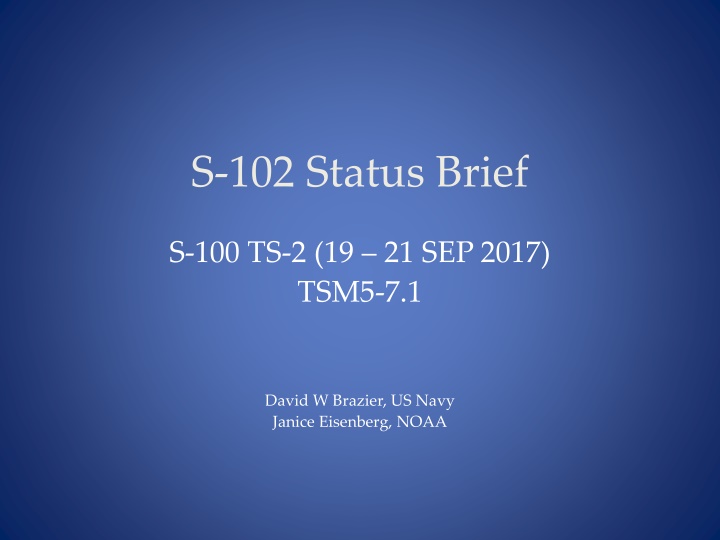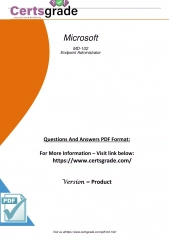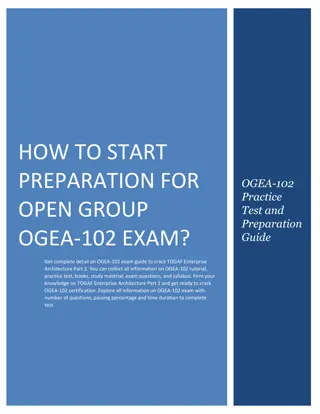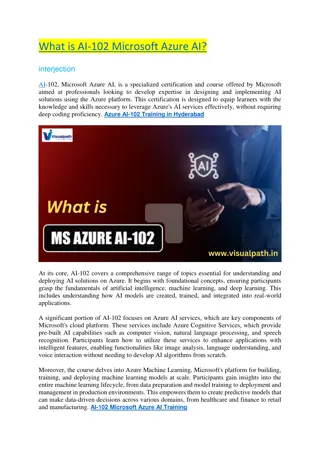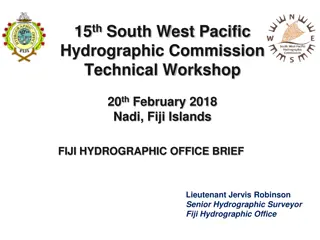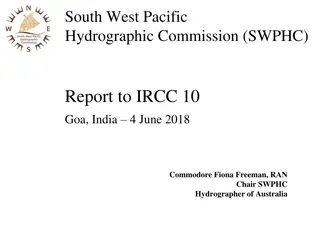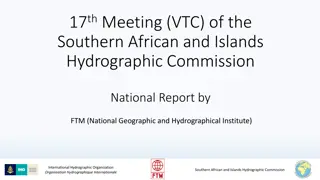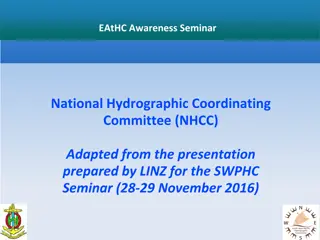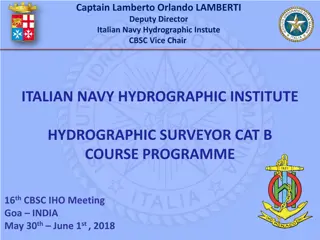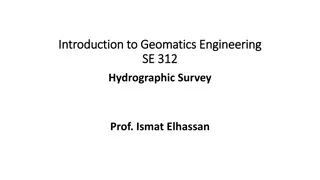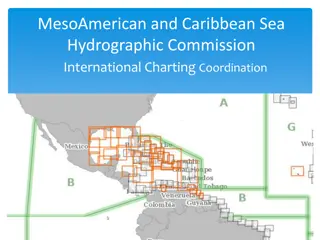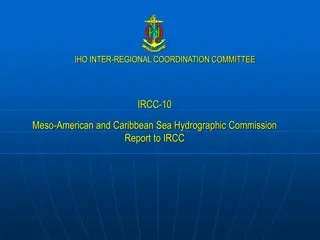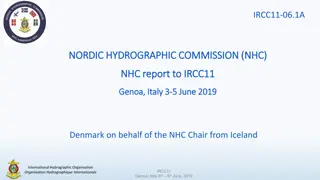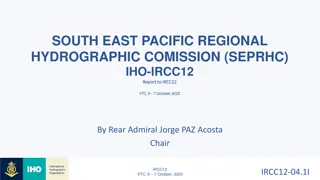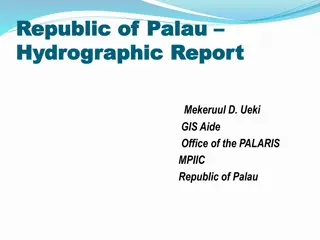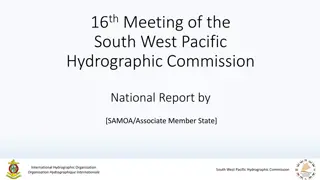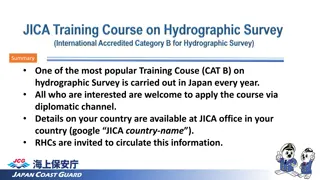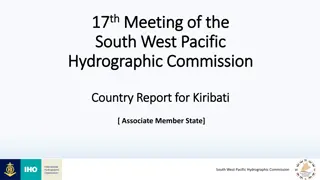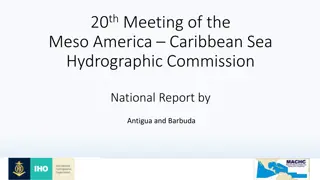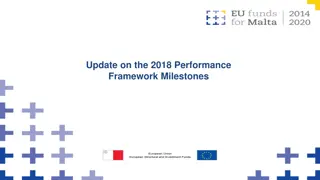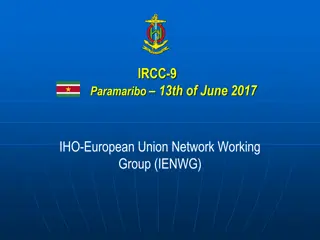S-102 Hydrographic Project Team Milestones and Focus Areas
The S-102 project team, led by David W. Brazier from the US Navy and Janice Eisenberg from NOAA, has been focusing on finalizing the portrayal, gridding methodology, grid resolution, and other guidance for the S-102 dataset. They are working towards submitting the finalized version for variable-resolution gridding by May 2018. The team is also addressing potential legal issues with automated routines for safe and unsafe water delineation.
Download Presentation

Please find below an Image/Link to download the presentation.
The content on the website is provided AS IS for your information and personal use only. It may not be sold, licensed, or shared on other websites without obtaining consent from the author.If you encounter any issues during the download, it is possible that the publisher has removed the file from their server.
You are allowed to download the files provided on this website for personal or commercial use, subject to the condition that they are used lawfully. All files are the property of their respective owners.
The content on the website is provided AS IS for your information and personal use only. It may not be sold, licensed, or shared on other websites without obtaining consent from the author.
E N D
Presentation Transcript
S-102 Status Brief S-100 TS-2 (19 21 SEP 2017) TSM5-7.1 David W Brazier, US Navy Janice Eisenberg, NOAA
S-102 Project Team Areas of Focus Project Team effort since S-100WG2 (March 2017): Finalize Portrayal Describe Gridding Methodology Define Grid Resolution Guidance Finalize File Size Limit Guidance Investigate Use of a Tiling Scheme Finalize Coordinate Reference System Generate an Actual S-102 Dataset Establish path for variable-resolution gridding (Fall 2017) Project Team Milestone: Finalize S-102 v2.0 for submission to HSSC9 (May 2018).
S-102 Portrayal (Options Proposed at S-100 WG2) Depth/Uncert. from Cursor 182 189 183 96 154 191 191 193 182 182 182 182 155 Related image 152 Depth: 19.2 Uncertainty: 0.11 Auto Selected Soundings - Safe/Unsafe Colouring - Auto Generated Safety Contour U N S A F E S A F E 19m Safety Contour Auto Generated Contours
S-102 Portrayal (Post S-100 WG2) Rejected Portrayal Accepted Portrayal 182 189 191 183 96 154 191 193 182 182 182 182 155 Auto Selected Soundings 152 Unsafe Auto Generated Contours Related image Safe Depth: 19.2 Uncert: 0.11 Auto Safety Contour Potential legal issues with automated routines executed by mariner. Delineation of safe (white) and unsafe (grey) water based on mariner input parameters. Ability to view S-102 nodal depth and uncertainty based on location of the ECS system cursor. Current automated functions still require hydrographer interaction.
S-102: Describe Gridding Methodology Hydrographic software provides multiple gridding options: Shoal Biased (center node) Shoal Biased (true position) Average Basic Weighted Mean Combined Uncertainty Bathymetry Estimator (CUBE) No one gridding option is ideal! Project Team agreed that it was up to the HO to identify their gridding method. What is required is the ability to capture the gridding method within the S-102 metadata.
S-102: Define Grid Resolution Question: How should the grid resolution be determined? Compilation Scale Grid Size There are a number of factors to consider: (1) What is the intended use of the S-102 dataset (e.g., to enable precision navigation, for generalized bathymetry, etc.) (2) Will the product be visible on ECDIS at the specified display scale (3) File Size (function of both grid resolution and tile size). (4) Interoperability with S-101 will also have to be considered. 1:10,000,000 900 m 1:3,500,000 900 m 1:1,500,000 ???? 1:700,000 210 m 1:350,000 105 m 1:180,000 54 m The German Hydrographic Office proposed a grid resolution scheme derived from requirements in the ENC product specification ( linear features must not be encoded at a point density greater than 0.3mm at compilation scale ). 1:90,000 27 m 1:45,000 13 m 1:22,000 6 m 1:12,000 3 m The Finnish Transport Agency (FTA) noted that complex bathymetry areas may require higher grid resolutions. FTA s solution is to create a surface model with a base resolution of 5m and generalize to coarser resolutions (10m, 20m, 50m). Some areas, however, may require local surface models with higher resolution (1m to 2.5m). 1:8,000 2 m 1:4,000 1 m 1:3,000 1 m 1:2,000 1 m 1:1,000 1 m This is an ongoing discussion. Grid Size (ENC Spec)
S-102: Why is Grid Resolution Important? What is the source of modern bathymetry? Modern sonars are high resolution collection systems. Example: SIMRAD EM2040 Beam Width (1 x 0.5 ) - 400 Soundings per ping (single swath / single receiver) - 800 Soundings per ping (dual swath / single receiver) - 800 Soundings per ping (single swath / dual receiver) - 1600 Soundings per ping (dual swath / dual receiver) Max ping rate (20 Hz) Coverage (5.5 times water depth) At 40 meters the nadir footprint is 0.7m x 0.35m: 0.7 m Rate of collection: 400 soundings X 20 pings/sec = 8000 soundings/sec. 0.35 m
S-102: Why is Grid Resolution Important? A single thirty (30) day survey (12 hour days): 345.6 million soundings collected each day 10.4 billion soundings collected each month Survey coverage at 8kts: 39 km2 / day 1172 km2 / month Hydrographic Offices utilize gridded surfaces to process bathymetry: Typical grid size in 40 meters of water: 1-meter To grid up entire survey area at 1-meter resolution: 554.4 million nodes The final 1-meter grid is the Navigation Surface
S-102 Why is Grid Resolution Important? To produce a 1:22K ENC: 1. Defocus the 1-meter Navigation Surface to 6-meters. 554.4 million nodes (1-meter navigation surface) 92.4 millions nodes (6-meter production grid) 2. Select soundings from the 6-meter grid. ~500 to 1000 soundings make it to a digital chart, or < 1% of the original data. 169 nodal depths underneath a single charted sounding 3.5 mm or 77 m real world 20 *IEC 60945 specifies that character size in mm be not less than 3.5 x the viewing distance in metres. Hence "readable from 1 metre" requires that characters be not less than 3.5 mm in size."
S-102: File Size Limits Current Draft S-102 v2.0 identifies two file size limits: Datasets must not exceed 10MB for transmission (wireless to platform). Datasets must not exceed 256 MB for physical media transfer to platform. HO s must consider the following to comply with spec.: Base Record Size for an S-102 File Grid Resolution Potential Tilling Scheme
S-102: File Size Limits (NAVO paper exercise) S-102 Dataset Compilation Scale Grid Size 1:10,000,000 900 m 4 MB S-102 Header 1:3,500,000 900 m 1:1,500,000 ???? 1:700,000 210 m 1:350,000 105 m Depth Layer 1 (True Depth) 8 bytes 1:180,000 54 m 1:90,000 27 m Depth Layer 2 (Nominal Depth) 8 bytes 1:45,000 13 m 1:22,000 6 m 48 bytes 8 bytes 1:12,000 3 m Uncertainty 1:8,000 2 m 1:4,000 1 m 24 bytes Vertical Control 1:3,000 1 m 1:2,000 1 m 1:1,000 1 m Example: a 6-meter grid at 1:22,000 scale - 12km X 12km (2000 rows x 2000 columns) = 4,000,000 grid cells - (4,000,000 cells X 48 bytes/cell) / 1,048,000 bytes = 183 MB - 183 MB + 4 MB (header) = 187 MB
S-102: File Size vs. Tile Size (NAVO paper exercise) Related image 3-meter grid (1:12,000) (1200 rows X 2300 columns) ~126 MB Chart Scale Grid Size 1:10,000,000 900 m 1:3,500,000 900 m 1:1,500,000 ???? 1:700,000 210 m 1:350,000 105 m 3.6 km 1:180,000 54 m 1:90,000 27 m 1:45,000 13 m 1:22,000 6 m 1:12,000 3 m 1:8,000 2 m 6.9 km 1:4,000 1 m 1:3,000 1 m 1:2,000 1 m 1:1,000 1 m 42 m ~ 100 grid cells underneath a single 7- meter sounding
S-102: Tiling Scheme Related image < 256 MB < 256 MB < 256 MB < 256 MB < 256 MB < 256 MB < 256 MB < 256 MB < 256 MB < 256 MB < 256 MB < 256 MB < 256 MB < 256 MB 3-meter S-102 Surfaces 2300 1-meter S-102 Surfaces 2300 Resolution Independent < 256 MB
S-102: Coordinate Reference System Question: Should S-102 utilize geographic or projected CRS? Geographic CRS Pros S-101 and S-102 product extents will be consistent, since S-101 utilizes geographic CRS (EPSG:4326/WGS84) OEMs (ECDIS manufacturers) won t need to re-project data Cons Inconvenient at higher latitudes Requires that positions be reported as floating point numbers; inaccuracies in floating point calculation may yield positional uncertainties in generalization Projected CRS (e.g., all UTM zones in WGS84) Pros Product boundaries will conform to a regular grid Cons S-101 and S-102 product extents won t be consistent HOs may have products that cross zones
BAG to S-102 Conversion Script Original Milestone: US Navy Completes Script by August 2017. Adjusted Milestone: Complete Script by December 2017. Post-Development Actions: US Navy (Naval Oceanographic Office) deliver script to SPAWAR US Navy (Naval Oceanographic Office) seek Public Release and deliver script to IHO (est. ~ January 2018). What Does Script Do? BAG Header S-102 Header (converted) BAG to S-102 Script Depth Layer 1 (Original) Depth Layer 1 Depth Layer 2 (Original) Depth Layer 2 Uncertainty (Original) Uncertainty Vertical Control (Original) Vertical Control
Remaining Actions: Post S-100 TS-5 1. Consolidate information from investigation period. 2. Disseminate this information to entire project team near the end of September 2017. Obtain final decision from project team (Survey Monkey?) 3. Establish path for variable-resolution gridding. 4. Finalize v2.0.0 of the product specification.
